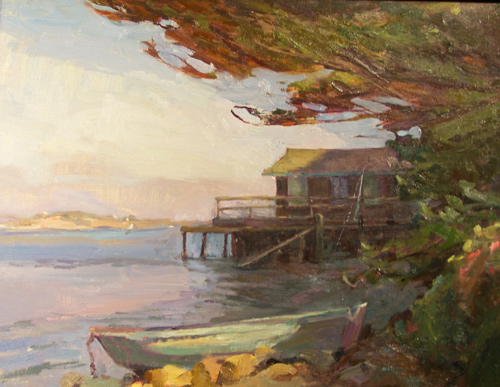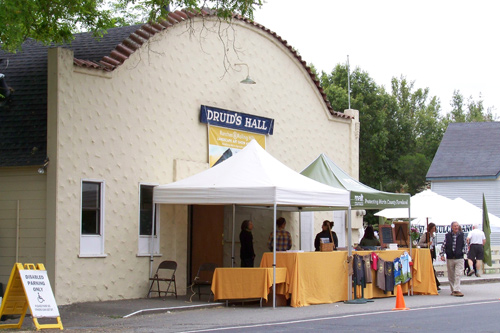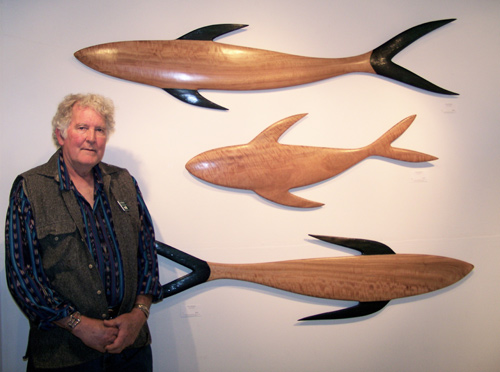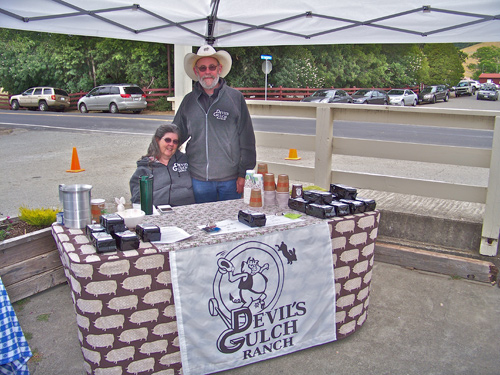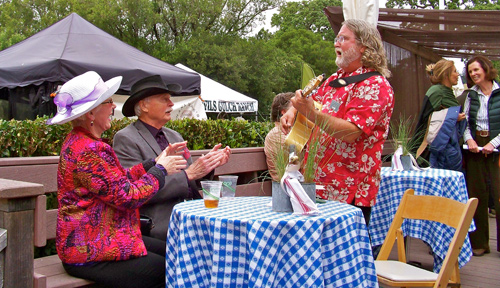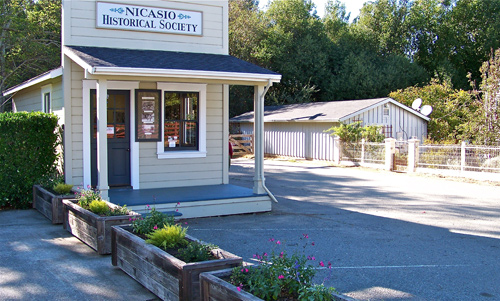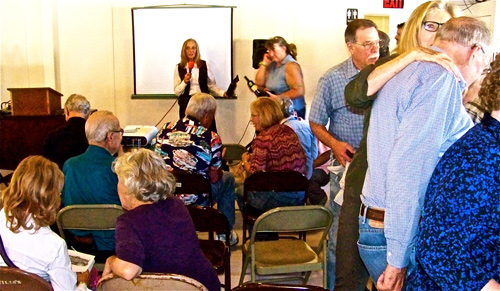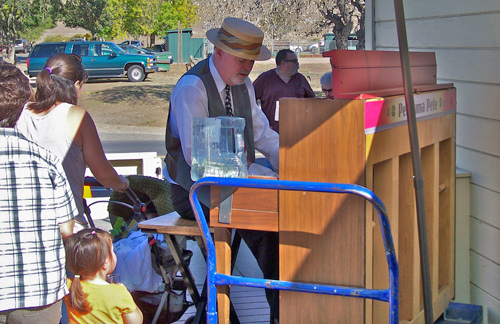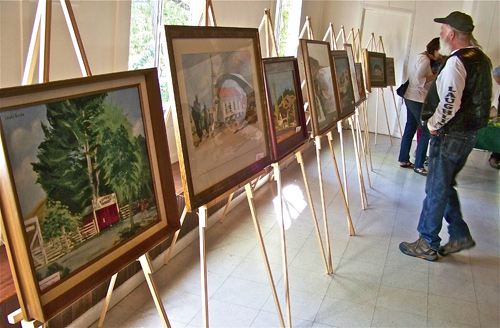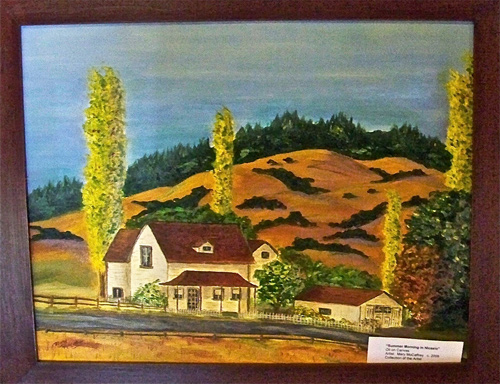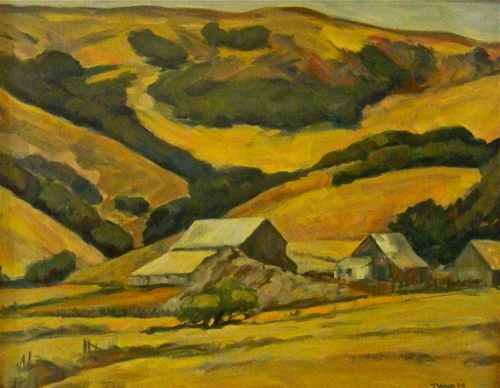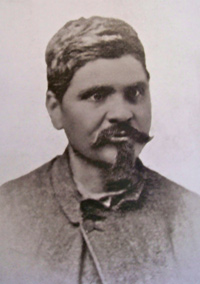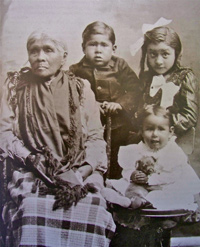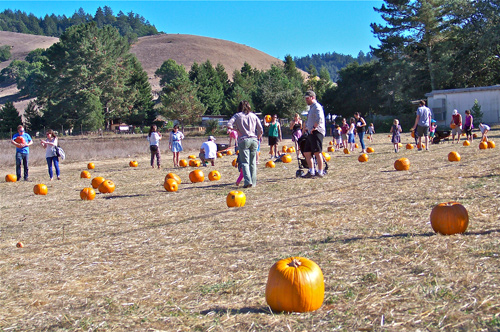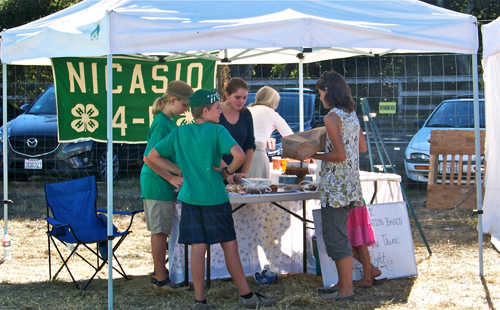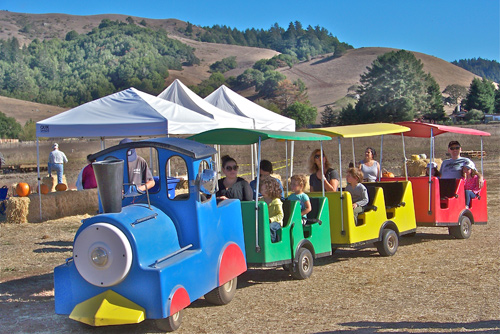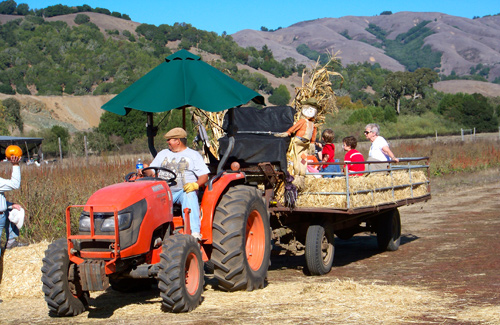Entries tagged with “MALT”.
Did you find what you wanted?
Sun 17 May 2015
Marin Agricultural Land Trust held its annual art show in Nicasio’s Druid Hall this past weekend. What a crowd! The landscapes on display were reminders of the beauty and tranquility now being protected forever by MALT conservation easements.
The popular art show is one of MALT’s sources of income, and local artists share part of the selling price to take part. For MALT’s explanation of what it does, click here.

Shep and Bugeyes, Barinaga Ranch. By Christin Coy

Hidden Tomales. By Jeanette LaGrue

Nicasio Druid Hall was packed with folks checking out the 18th annual Ranches and Rolling Hills Landscape Art Show and Sale.

Wood sculptor Bruce Mitchell with three of his impressive works made from eucalyptus: Fossil Fish No. 1 (middle), No. 3 (on top), and No. 4 (on the bottom). Fossil Fish No. 2 was across the room on a different wall.

Nicasio artist Thomas Wood lives on the town square only a few doors from the Druid Hall where these paintings by him were on display.

A guest talks with artist Robert Steele. This was his second year to be admitted in the selective show.

This was artist Ane Carla Rovetta’s 17th MALT show. She lived in Point Reyes Station for 27 years, she said, until the cost of housing convinced her to get a small home in Petaluma.

Miriam and Mark Pasternak of Devil’s Gulch Ranch in Nicasio sold packages of ground coffee.

Barns Above Drakes Beach. Michael Drury

Entertaining guests on a deck outside the main hall was William Mitchell, one of the artists in the show. _________________________________________________________________
 California Vineyard, Hills. Millicent Tompkins
California Vineyard, Hills. Millicent Tompkins
______________________________________________________
Tags: Ane Carla Rovetta, Bruce Mitchell, Christin Coy, Jeanette LaGrue, MALT, Marin Agricutural Land Trust, Mark Pasternak, Michael Drury, Millicent Tompkins, Miriam Pasternak, Nicasio Druid Hall, Robert Steele, Thomas Wood, William Mitchell
Mon 20 Oct 2014
Posted by DavidMitchell under History
1 Comment
Two major events drew crowds to Nicasio last weekend. One was in the center of town Saturday, the other on the edge of town Sunday, and that was in addition to the usual throng who showed up for Rancho Nicasio’s weekend music.

On Saturday, the Nicasio Historical Society held a grand opening for its new headquarters and museum on Nicasio Square. Out of necessity, most of the celebration took place in the Druids Hall next door. The museum itself is so small it would have been overwhelmed if 20 people had tried to squeeze inside.

In the Druids Hall, Elaine Doss, president of Nicasio Historical Society, urges a crowd of talkative history buffs to take their seats so the presentations can resume. The Historical Society was founded 10 years ago.
I wasn’t surprised that there was a fair amount of public interest in the opening, which included refreshments, music, art, and history talks by Dewey Livingston and Betty Goerke. The interest, however, proved to be so great that even Druids Hall was close to being overwhelmed.

Entertaining guests outdoors was piano man Petaluma Pete.

The town and especially its square are favorite locales for en plein air painters, and several Nicasio paintings were on display inside the Druids Hall.

‘Summer Morning in Nicasio’ by MaryMcCaffrey.

Detail from ‘Gallagher Ranch’ by Tom Wood. The artist happens to be one of the museum’s neighbors. ________________________________________________________________
Among the most fascinating displays at the museum opening was an exhibit of Miwok Indian history. Artifacts suggest that a Miwok village referred to as Echatamal had existed in the Rancheria Road area as far back 1400.
 Between 1783 and 1817, however, the Spanish Mission system took 1,700 Miwok from their homes throughout Marin County to work for Mission Dolores in San Francisco. Only 485 of them survived, according to the exhibit.
Between 1783 and 1817, however, the Spanish Mission system took 1,700 Miwok from their homes throughout Marin County to work for Mission Dolores in San Francisco. Only 485 of them survived, according to the exhibit.
Many of the survivors were then moved to Mission San Rafael.
When the Mexican government ended the mission system in 1834, Governor José Figueroa decreed that each head of family and male Indian receive somewhere between two and 29 acres, as well as some of the mission’s livestock.
Five Coast Miwok received a total of approximately 80,000 acres in Nicasio but by 1870 had lost ownership of the land to white settlers. A few Miwok families continued living on the land, but a number of others moved to Marshall.
The only Indian who was able to actually buy traditional Miwok land was chief José Calistro (above), who in 1872 bought 24.53 acres surrounding his village at Nicasio for $980 in gold coin. However, chief Calistro died five years later, and in 1887, his son sold the land to his lawyer for $5. ________________________________________________________________
 Much of what is known about the final days of the Miwok in Nicasio comes from the late Mary Copa.
Much of what is known about the final days of the Miwok in Nicasio comes from the late Mary Copa.
Mary Copa’s mother, Jauna Bautista, is seen here with her grandchildren, Joseph Monzaga, Julia Frease, and Edward Monzaga.
Nicasio, by the way, takes its name from a Miwok from the area. He was given the name Nicasio in 1808 when at the age of 20 he was part of a group of Indians baptized en masse at Mission Dolores.
The name originates with a 12th century Sicilian knight who fought in the crusades. _______________________________________________________________

The next day, Sunday, was a fundraiser for Marin Agricultural Land Trust. The crowd who showed up for MALT Day at Nicasio Valley Farms Pumpkin Patch was even bigger than the previous day’s.
Along with pumpkin picking and perusing the wares of the adjoining Nicasio Valley Cheese Company, people could get information about MALT, which was founded as a nonprofit alliance of environmentalists and conservation-minded ranchers.
Using grants, donations, and bond money, MALT buys agriculture-conservation easements from ranchers. The easements guarantee their land will be kept in agriculture in perpetuity, thus remaining open space without any commercial development or subdividing.

Squealing all the way, youngsters enthusiastically went down a giant slide during MALT Day.

It wouldn’t be a community celebration in West Marin without a 4-H bake sale.

Kids got a chance to ride a mechanical bull a la ‘Urban Cowboy’ but at a slower speed and with a softer landing should anyone get bucked off.

One way to keep the children entertained was to take them on train rides. _______________________________________________________________
 As many girls as boys overcame any fear of heights and clambered up the face of a MALT Day monolith.
As many girls as boys overcame any fear of heights and clambered up the face of a MALT Day monolith.
Using handholds children got their exercise climbing and then used their safety lines to rappel back to the bottom.
_____________________________________________________________

It wouldn’t be a harvest festival without a hayride, and for many youngsters this was their first.
Nicasio is in the geographic center of Marin County, and for that reason some landowners once proposed that Civic Center be built here; however, it was deemed too remote for East Marin residents. As a result, the town today has a population of only 96. At least according to the 2010 census. Yet it sure knows how to host a lot of fun. ________________________________________________________________
Sat 8 Dec 2012
Posted by DavidMitchell under agriculture, History, Point Reyes Station, West Marin nature
Comments Off on Pearl Harbor Day, Point Reyes Station’s Christmas tree lighting, and a new era at MALT
“What kind of a day was it? A day like all days, filled with those events that alter and illuminate our times….” Walter Cronkite

The USS Arizona burning after Japanese torpedo bombers attacked the battleship on Dec. 7, 1941.
Japan’s attack at Pearl Harbor, Hawaii, killed 2,402 people and wounded another 1,247, plunging the US into a war that ultimately cost America and its allies more than 61 million military and civilian lives. Axis countries lost more than 12 million lives.
My father used to tell me about from coming home from church in San Francisco that Sunday, Dec. 7, when a neighbor shouted out the window to him that the Japanese had just attacked Pearl Harbor. Friday was the 71st anniversary of the attack, and heavily attended memorial ceremonies were held from Pearl Harbor, to the Coast Guard Station in Alameda, to New York and Washington, DC.
Some West Marin’s responses to the attack were described in a Tomales Regional History Center bulletin earlier this year: Tomales High “student Kathie Nuckols (Lawson) clearly remembered the Monday morning of Dec. 8, 1941, little more than 24 hours after Pearl Harbor was bombed. “Our principal called all the students into the auditorium to hear President Roosevelt call our country to war. His voice came through a small radio, and we strained to hear his words, overwhelmed by the drama as only teenagers can be.
“Blackout shades lowered in the auditorium, tanks passing the school on their way to occupy Dillon Beach, the imposed limits on travel because of gas rationing, especially affecting the sports programs…. These are some of the things students of the war years remembered. Yet these events were undoubtedly put into perspective by the biggest effect of all, the nine Tomales High students who did not come home from the war.”

The annual Christmas-tree lighting in Point Reyes Station drew a large crowd Friday evening. The tree is on the landscaped median between the Palace Market parking lot and the parking lot of Wells Fargo Bank, which handed out hot chocolate and sweets.

Phyllis Faber
Meanwhile at the Dance Palace community center, Marin Agricultural Land Trust held its annual dinner Friday. Now an octogenarian, Phyllis Faber, a biologist, and the late Ellen Straus, a rancher, founded MALT in 1984 to give permanent protection to family farms. It was a time when economic pressure to subdivide the coast was spurring ranchers to sell their land to developers. The farmland trust became the first of its kind in the nation.

A red-shouldered hawk is still able to hunt the pastures around Mitchell cabin thanks to a century and a half of ranching, which served to protect much of West Marin from over-development.

Bob Berner, who has been MALT’s executive director since its founding 28 years ago, will retire next month, and Friday he gave an emotional farewell to MALT supporters in the Dance Palace.
Under Berner’s leadership, MALT has bought agricultural easements from 69 ranchers, guaranteeing that at least half of all Marin County’s family farms will forever remain in agriculture.

A herd of blacktail deer take advantage of West Marin’s open land to graze near Mitchell cabin.

MALT’s new executive director as of Jan. 14 will be Jamison Watts, who happens to be a great, great grandson of naturalist John Muir’s sister, Margaret Muir Reid. Watts for the past six years has been the executive director of the Northern California Regional Land Trust (NCRLT).
Watts, who inherited the Muir family’s interest in conservation, earned a degree from UC Davis in Environmental Biology with an emphasis in Conservation Biology. He spent the next 12 years as a field and wildlife biologist, while simultaneously earning a master’s degree in Biological Sciences, before going to work for NCRLT in 2006.

Much of the Rich Readimix plant was under water when Papermill Creek overflowed its banks on New Year’s Eve 2005.
In sadder news this week, The West Marin Citizen reported that the Rich Readimix plant on the Point Reyes-Petaluma Road is about to close after more than 60 years in operation.
Don and Doug Joslin created the cement plant during the 1950s, and it was so well known throughout West Marin that nearby Platform Bridge was commonly referred to as Joslin Bridge. After 35 years, the Joslins sold the plant to Rich Readimix, which also has a plant in Greenbrae. All the workers at the West Marin plant will now be transferred to Greenbrae.
Tue 11 Sep 2012
Posted by DavidMitchell under agriculture, General News, West Marin nature, Wildlife
Comments Off on Why Marin needs to approve Measure A
With the quality of county parks, open space, ranchlands, and water on the line, Marin voters on Nov. 6 need to approve a quarter-cent increase in the county sales tax. A two-thirds majority is required for passage.
County Open Space and Parks Director Linda Dahl spent months preparing the tax proposal, Measure A, which the Board of Supervisors on Aug. 7 agreed to place on the November ballot. If approved, the tax is expected to bring in $10 million annually over its nine-year lifetime.
Dahl’s department would get 65 percent of the revenue, which would be used for maintenance and repairs at parks, as well as buying land easements and trail connections in natural areas, as my partner Lynn Axelrod reported in The West Marin Citizen. Cities, towns, and special districts that oversee parks and recreation would receive 15 percent, which they could use to maintain and expand parks, as well as reduce the risks of wildfires.
The remaining 20 percent would be allocated to a Farmlands Protection program for, among other things, buying conservation easements on farms and ranches. Here is how revenue from the tax measure would be allocated, according to the measure.

Additional maintenance at White House Pool, a county park along Papermill Creek, would be eligible for funding under Measure A.
Parks and Open Space Program: Eighty percent of this program’s annual amount will be used to protect and restore wetlands along the coastline and bay shoreline to protect wildlife habitat; to protect water quality and fish habitat by reducing erosion and sedimentation; to reduce the risk of wildfire, enhance biodiversity, and control invasive, non-native weeds; to repair, maintain, and/or replace deteriorating facilities in open-space preserves and parks; to prevent slope instability and flooding; to build new or modify existing trails, entering into arrangements with private landowners for trail connections; to augment visitor services.
Preserving natural lands would include purchasing land or conservation easements from willing sellers. To the extent possible, tax revenues would be used to leverage matching funds from public and private ‘partners.’

These might be considered “sacred cows” because ranching is what keeps much of West Marin in open space. If ranching gets too tough here, subdividing might replace much of it; Measure A, however, would help buy, from ranchers, easements that lock their land into agricultural uses in perpetuity.
Farmland Preservation Program: The purpose of this program is to protect county farmland at risk of subdivision and development and to preserve working farms and ranches. Money could be used to buy perpetual agricultural-conservation easements and to buy additional real-property interests on lands now covered by such easements.
Marin Agricultural Land Trust (MALT) already buys and holds such easements, and the program’s 20 percent of tax revenues could be used to provide matching grants to ‘qualified organizations’ (e.g. MALT) to buy and support purchase of more easements. Up to 5 percent of the Farmland Preservation Program’s allocation would be used for monitoring and enforcing easements. And up to 5 percent of the allocation would be shared with the Marin Resource Conservation District to assist ranchers on easement-protected properties.
City, Town, and Applicable Special-district Program: This program would provide local governments with funds to maintain and restore existing parks and recreational facilities; to acquire new parks; to carry out vegetation management. This program is expected to be allocated more than $13.5 million over the life of the measure.
The county Parks and Open Space Commission will conduct an annual meeting to gather public opinions as to what projects should be funded. No more than 5 percent of the Parks and Open Space allocation can be used for administrative expenses by the county. The same is true for the Farmland Preservation Program.
MALT, which helped Parks and Open Space director Dahl prepare the ballot measure, is expected to be put in charge of acquiring agricultural easements. Bolinas resident Cela O’Conner, who bitterly opposed Supervisor Steve Kinsey’s reelection, criticized the board’s allocating money through MALT since it is a private nonprofit; however, the organization’s executive director Bob Berner told county supervisors, none of the tax money would “stick” to MALT or be used for salaries.
It would all go to acquiring and maintaining easements. Berner said MALT has already spent $54 million acquiring easements that protect 44,000 acres. Half of the money has come from public funds, he noted, but money from those sources, especially the California Coastal Conservancy, is “about exhausted.”
Affordable-housing advocate Dave Coury told the supervisors the ballot measure is “a pig in a poke” because the county has not yet decided what additional land might be purchased for open space.
The Marin County League of Women Voters, while not taking a stand on Measure A, pointedly asked Supervisor Kinsey in writing: “Is it wise to put the proposal on this November’s ballot when the governor’s tax plan will also appear? We’re concerned that Marin’s competing proposal may serve to generate stronger opposition to that plan in Marin.”
Kinsey responded, “We understand the dire needs in our community that the state measure would address. We support the state measure, and would not be proposing our local measure unless we were confident that it would not affect the statewide one.”
The league also asked, “What are the thoughts of the supervisors on other potential revenue sources that may be less regressive and fairer? In particular, have fees or parcel taxes been considered? These more closely tie those paying for the services to the benefits.”
Kinsey’s response: “Sales tax is a broad-based tax, so it doesn’t create a burden for one segment of our community. Our parks are used by all residents of our community, not just property owners, so there is a nexus between who pays and who uses our parks and open space. Sales tax may actually be fairer since it includes all residents (park and open space users) not just homeowners, and especially since visitors from out of the county who use our regional, state and national parks also pay a portion of the sales tax collected in this county.”
Speaking in favor of the tax proposal during the supervisors’ hearings were ranchers Dominic Grossi, Rick and Scott Lafranchi, Sam Dolcini, and Loren Poncia. Another supporter, rancher Ralph Grossi, former head of the American Farmland Trust headquartered in Washington, DC, told the supervisors he expects federal matching grants will be available from the current Farm Bill.
Also testifying in favor of Measure A, The West Marin Citizen reported, were the Marin Conservation League, Marin Audubon Society, the Marin Bicycle Coalition, Access 4 Bikes, and Conservation Corps North Bay.
Measure A’s benefits for Marin County are substantial, and I urge readers to wholeheartedly support it.
Sun 5 Jun 2011
The sun shone Sunday on the Western Weekend parade in Point Reyes Station. Despite a week of off-and-on rain leading up to the parade, the weather was sunny and warm.
 Receiving applause all along the main street, a Coast Guard color guard headed up the parade.
Receiving applause all along the main street, a Coast Guard color guard headed up the parade.

Western Weekend queen Alyssa Tanner (left) and princess Jessica Arndt together made a second trip down the three-block-long parade route after riding in separate vehicles at the start of the parade. At the wheel of the 1936 Ford Phaeton is owner Jon Langdon of Inverness.
 .
.
El Radio Fantastique sponsored by Vladimir’s Restaurant in Inverness won the grand prize trophy. Riding on a lowboy trailer pulled by a truck, the band led by Giovanni DeMorenti (in red) performed New Orleans-style jazz and blues.
 .
.
El Radio Fantastique also won a trophy and a first-place ribbon in the adult music category. Marching ahead of the band was fire-eater Bonnie Porter. Circling the float on bicycles were a pair of winged fairies, including Miss June at left.
 Pete Tomasetti Tractors won the first-place ribbon in the Farm Vehicle division. The orange tractor was built in 1938, the red one in 1941.
Pete Tomasetti Tractors won the first-place ribbon in the Farm Vehicle division. The orange tractor was built in 1938, the red one in 1941.

The first-place ribbon and a trophy in the adult-street-show division went to the Mainstreet Moms, who oppose nuclear development.
 The West Marin Citizen’s entry celebrated the weekly newspaper’s fourth anniversary.
The West Marin Citizen’s entry celebrated the weekly newspaper’s fourth anniversary.
 The Aztec Dancers won a second-place ribbon in the best-drill-team judging.
The Aztec Dancers won a second-place ribbon in the best-drill-team judging.
 For his parade entry, Jason McLean built and rode a deer with fire belching from its tail.
For his parade entry, Jason McLean built and rode a deer with fire belching from its tail.
 Taking the second-place ribbon in adult street shows was the Inverness Garden Club.
Taking the second-place ribbon in adult street shows was the Inverness Garden Club.
 Escorted by two goats, Violet (wearing brown) and Avie (in a white-and-black wool coat), Devil’s Gulch Ranch Camp in Nicasio won a first place ribbon in the kids’ animal competition and a trophy in the adult-animal judging.
Escorted by two goats, Violet (wearing brown) and Avie (in a white-and-black wool coat), Devil’s Gulch Ranch Camp in Nicasio won a first place ribbon in the kids’ animal competition and a trophy in the adult-animal judging.
 The ever-popular Nave Patrola won a trophy and first-place ribbon in the best-drill-team judging. The group spoofs the Italian army in World War I. Although the Italian consulate in San Francisco back in the 1970s complained that their bumbling antics denigrate Italians, the Nave Patrola, which includes several members of Italian descent, has continued to take part in the parade every year.
The ever-popular Nave Patrola won a trophy and first-place ribbon in the best-drill-team judging. The group spoofs the Italian army in World War I. Although the Italian consulate in San Francisco back in the 1970s complained that their bumbling antics denigrate Italians, the Nave Patrola, which includes several members of Italian descent, has continued to take part in the parade every year.
 Papermill Creek Children’s Corner preschool won the first-place ribbon in the kids’ drill team category.
Papermill Creek Children’s Corner preschool won the first-place ribbon in the kids’ drill team category.
 Taking the first-place ribbon in kids’ music were 7th and 8th graders from West Marin School. The 6th graders won the second-place ribbon.
Taking the first-place ribbon in kids’ music were 7th and 8th graders from West Marin School. The 6th graders won the second-place ribbon.
 County Supervisor Steve Kinsey (second from left in foreground) led the Marin Agricultural Land Trust (MALT) float, which took the first-place ribbon for an adult float.
County Supervisor Steve Kinsey (second from left in foreground) led the Marin Agricultural Land Trust (MALT) float, which took the first-place ribbon for an adult float.
 The trophy plus a first-place ribbon in the kids’ float judging went to the 4-H Bake Sale float.
The trophy plus a first-place ribbon in the kids’ float judging went to the 4-H Bake Sale float.
 Pirates and Crew with Carol Rossi received a first-palace ribbon in the adult-animal division.
Pirates and Crew with Carol Rossi received a first-palace ribbon in the adult-animal division.
 Straus Family Creamery in Marshall used the parade to promote its new banana-flavored ice cream, passing out free samples to spectators along the parade route.
Straus Family Creamery in Marshall used the parade to promote its new banana-flavored ice cream, passing out free samples to spectators along the parade route.
The Staus entry won a third-place ribbon in the adult vehicle category.
The judges for this year’s Western Weekend parade were Matt Murphy, Carol Friedman, Laurie Monserrat, and Kristi Edwards.
Robert Cardwell, as always, was the announcer at the judges’ stand in front of Toby’s Feed Barn.
Winning entries can pick up ribbons and trophies at The West Marin Citizen office on Fourth Street in Point Reyes Station.
Tags: 4-H, Bonnie Porter, Devil's Gulch Camp, El Radio Fantastique, fire eater, Jon Langdon, June DeMorenti, Mainstreet Moms, MALT, Nave Patrola, Pete Tomasetti Tractors, Steve Kinsey, West Marin Citizen, Western Weekend parade
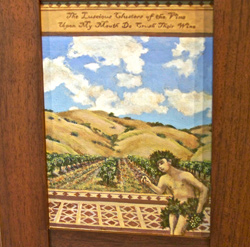 California Vineyard, Hills. Millicent Tompkins
California Vineyard, Hills. Millicent Tompkins

